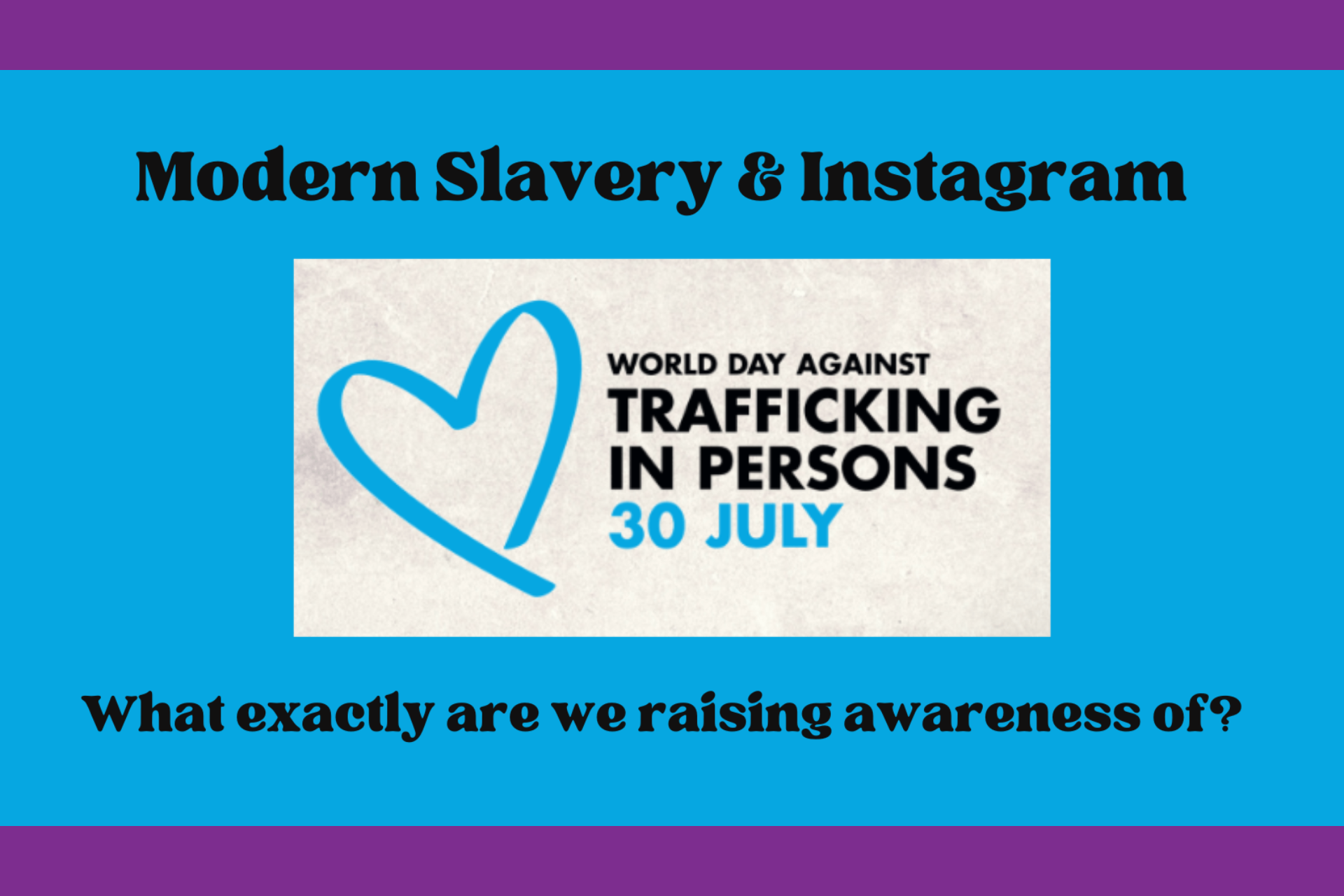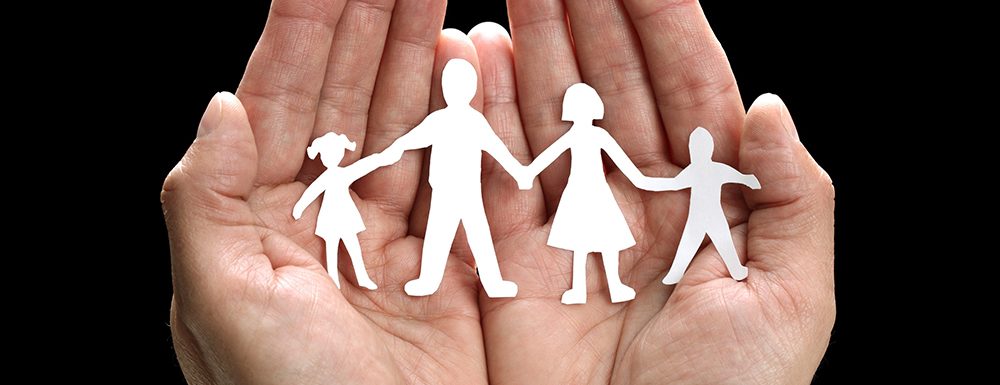
This is a guest blog written by Amy Plummer. Amy is a PhD student at St Mary’s University and is currently writing her thesis on representations of modern slavery on social media. Amy’s research is fascinating so we invited her to write a blog for our website, analysing the social media landscape for World Day Against Trafficking in Persons 2022. To contact Amy, please email her at [email protected] or connect with her on social media –@modernslavery_uk_activist on Instagram and Twitter @AmyVPlummer.
On 30 July 2014 the United Nations (UN) declared this day as World Day Against Trafficking in Persons, an annual day to raise awareness of human trafficking and the impact on victims. Human trafficking is a complex issue, defined by the United Nations as “the recruitment, transport, transfer, harbouring or receipt of a person by such means as threat or use of force or other forms of coercion, abduction, fraud or deception for the purpose of exploitation” (Palermo Protocol, 2000).
While the term ‘human trafficking’ is internationally used in discourse and legislation, the UK and Australia have adopted the ‘modern slavery’ term as enacted in the Modern Slavery Act 2015 and 2018, respectively. ‘Modern slavery’ has been labelled an ‘umbrella term’ which incorporates slavery, human trafficking and exploitation as offences under this legislation. The conflation of these terms throughout media, political, and activist discourse has led to the terms ‘modern slavery’, ‘human trafficking’ and ‘exploitation’ often used interchangeably.
Furthermore, these umbrella terms also include issues of forced labour, sexual exploitation, domestic servitude, county lines, criminal exploitation, child labour, child sexual exploitation, forced marriage, organ harvesting, and child soldiers, among others. With so many different forms of exploitation, causes, recruitment methods, legislation, physical and psychological impacts on survivors, and a range of prevention, prosecution, and protection efforts within these umbrella terms, it raises a question: what are we actually raising awareness of?
The Use and Abuse of Instagram
The World Day Against Trafficking theme for 2022 was ‘The Use and Abuse of Technology’ aiming to raise awareness of how technological advancements have both helped disrupt, as well as facilitate human trafficking. Social media plays a vital role in communication in the modern world, allowing for people to interact with one another and share information and ideas faster than ever before. With an estimated 1.4 billion monthly active users (according to The Small Business Blog), Instagram is a uniquely image – and video – focused platform where users can post, like, comment, and share posts with one another, where online strangers are rebranded as ‘followers’.
For raising awareness of issues like human trafficking, Instagram can be a valuable tool for reaching widespread audiences, creating informative content, and endorsing anti-trafficking organisations and the valuable work being done. Unfortunately, there has also been growing concerns over the use of platforms like Instagram for the grooming and exploitation of young people. Online ‘followers’ and ‘friends’ are becoming young people’s real friends and confidants – gaining their friendship and trust which perpetrators use for exploitative purposes. Additionally, there is a growing risk of misinformation, fake news and the spread of conspiracy theories on Instagram. While awareness campaigns in the past were created by experts and professionals in the field, Instagram is a platform where anyone can create and share posts – regardless of accuracy or the risk of creating a moral panic.
World Day Against Trafficking in Persons 2022 Themes
For the 2022 World Day Against Trafficking in Persons, Instagram posts utilising the hashtags #endhumantrafficking and #worlddayagainsttrafficking features an expansive range of messages and images from selfies and event photos to high-profile news reports of R. Kelly and Ghislaine Maxwell, the ‘red flags’ and ‘signs’ of exploitation to look out for, and even pet dogs and holiday photos. While the official theme of technology was rarely visible, there was a persistent focus on the use of grooming as a recruitment method. Online grooming and exploitation are immense problems in the modern world, and it is encouraging to see a united focus on educating and providing guidance for young people, in addition to parents and guardians.
However, upon observing Instagram posts from this awareness day, several other common themes were evident which are slightly concerning:
- A focus on child trafficking, especially child sex trafficking with many Instagram users controversially using photos of their own children to state they are “not for sale” and that parents must “speak up for those who cannot speak for themselves”;
- Informative posts relying on attention-grabbing statistics, but often fail to provide little context or explain where the data came from;
- Posts encouraging people to “get loud”, “rise up”, “join the fight” and “end human trafficking”, but a lack of suggestions of how to do so.
While many posts offer informative and helpful information to viewers, there is also a disproportionate number of posts focused on encouraging viewers to do something to ‘end human trafficking’ without providing any suggestions of how to do so. There is an added risk on social media of the ‘mindless scroll’ through posts, and even those who feel empowered to do something may lose interest quickly in today’s fast-paced world if achievable and sustainable options to help in the anti-trafficking field are not suggested or available.
Online Awareness Raising Considerations
Modern slavery and human trafficking awareness raising efforts are certainly capable of being informative and making a meaningful difference in the anti-slavery and trafficking field. Everyone who works within this field has a story of how they learned about the issues and how this inspired them to do the work they do. Here are four things you may want to consider when creating a social media post:
1: Are you posting on social media for the sake of posting or to get ‘likes’?
Social media can be a tick on the to-do list or just simply a normal part of our everyday lives. When it comes to raising awareness of such complex and sensitive issues, there should be a deeper consideration of our aims for posting. Various apps can make creating social media posts fast and simple, but that does not mean we should simply ‘get the job done’. As individuals, charities, businesses, governments, and media sources that aim to raise awareness of modern slavery and human trafficking, we all have a responsibility to use social media purposefully and mindfully by thinking through each image and message. This may mean considering questions such as: What is the aim when posting this? Are there ways in which it might be harmful or used in harmful ways? If you’re posting on behalf of an organisation, how will it help move you towards your organisation’s mission and vision?
2: Where is your information coming from?
Many of the statistics used in social media posts are outdated and used without context. Which term and definition are being used, the number of potential modern slavery victims versus human trafficking victims, global statistics versus national statistics, and so on can be confusing for those wanting to learn about the issues. With so many different numbers swirling around on posts it’s important to do your research, provide context, and use numbers purposefully, not just to grab viewers’ attention. This may mean using reliable sources, referencing your source, providing context to data and explaining any limitations to this data.
3: Are there any implications for the images you are using?
Images are powerful but potentially harmful. Images of chains and ropes, for example, are still frequently used in modern slavery and human trafficking posts. While attention grabbing and often used to symbolise the freedom that is taken away from victims, they can be triggering for victims. Such images also fuel the common misconception that chains and ropes are still widely used methods of control. Psychological coercion, however, is largely missing from the discussion, despite it being commonly used by traffickers today. Psychological coercion is not visible, like chains and ropes, and this is also why it continues to be misunderstood.
4: Have you considered who might be viewing your posts?
Current victims, as well as survivors, of human trafficking may be on social media. Victims are not necessarily locked away without access to the outside world – they may have smartphones and be actively using platforms like Instagram. When creating posts, think about how the information and images used could potentially impact, trigger or be harmful to these individuals. A post may seem innocent or safe to us, but could have a significant impact on someone who has experienced or is experiencing trauma.
The importance of raising awareness of modern slavery and human trafficking is internationally agreed across political and activist spaces. It plays a vital role in encouraging individuals, businesses, governments, and charities to not only play their role but to work collaboratively to strengthen efforts. Despite some of the risks, it can be a powerful tool for reaching widespread audiences and delivering targeted messages. While a day like World Day Against Trafficking in Persons is a great opportunity to come together, it is important to remember that human trafficking is an issue the other 364 days of the year too, so we must not rely on one day alone, rather to use this day to empower and inspire global change all year long.
By Amy Plummer


